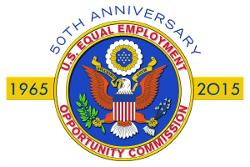
U.S. Equal Employment
Opportunity Commission
- Home
- About EEOC
- Overview
- The Commission & the General Counsel
- Meetings of the Commission
- Open Government
- Newsroom
- Laws, Regulations, Guidance & MOUs
- Budget & Performance
- Enforcement & Litigation
- Initiatives
- Task Forces
- Interagency Programs
- Publications
- Statistics
- Outreach & Education
- Legislative Affairs
- FOIA & Privacy Act
- Doing Business with EEOC
- Jobs & Internships
- EEOC History
- Office of Inspector General
- Employees & Applicants
- Employers / Small Business
- Federal Agencies
- Overview
- Federal Employees & Applicants
- Federal EEO Coordination
- Federal Agency EEO Directors
- Laws, Regulations, Guidance & MOUs
- Management Directives & Federal Sector Guidance
- Federal Sector Alternative Dispute Resolution
- Federal Sector Reports
- Appellate Decisions
- Digest of EEO Law
- Federal Sector EEO Portal (FedSEP)
- Form 462 Reporting
- Federal Training & Outreach
- Contact Us




